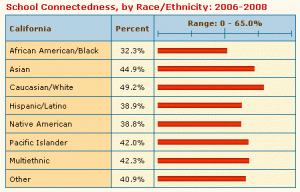How Connected Are CA Kids to their Schools?
As adults, we know that the health and success of a company depend, in part, on a positive working environment. When employees feel that their managers care, hold high expectations, and give meaning to their work, productivity increases.
This dynamic is similar in schools. Students want to feel valued, challenged, and encouraged to participate, and when they do, research has shown that these and other factors associated with school connectedness play a critical role in fostering resilience in kids. Resilience, in turn, has been associated with healthy development and the avoidance of risky behaviors.
But how do we measure a student’s connectedness to school? Over the past several years, the California Healthy Kids Survey (CHKS) – developed and administered by WestEd and the California Department of Education – has established a number of measures of school connectedness, and these data – broken out by gender and race/ethnicity – now are available on kidsdata.org for school districts for across California.
Among the highlights, these data from 2006-08 show that:
 Less than half of 7th, 9th, and 11th-grade students in California typically report high levels of connection to their school. This summary measure includes student reports of being treated fairly, feeling close to people, feeling happy, feeling a part of, and feeling safe at, school.
Less than half of 7th, 9th, and 11th-grade students in California typically report high levels of connection to their school. This summary measure includes student reports of being treated fairly, feeling close to people, feeling happy, feeling a part of, and feeling safe at, school.- Students’ connectedness to school varies
by race/ethnicity. Caucasian/White and Asian American students consistently are most likely to report high levels of connectedness, while African American/Black students are least likely to report such high levels. - About one half of 7th, 9th, and 11th grade students in California in 2006-08 reported high expectations from teachers and others at school. Across all racial/ethnic groups, students were more likely to say in 2006-08 that teachers had high expectations of them than in 2003-’05.
- About 15% of 7th, 9th, and 11th-grade students in California report high levels of meaningful participation in school. This is a summary measure of student reports of whether at school they do interesting activities, help make decisions, and “do things that make a difference.” A higher percentage of students – roughly one-third – report low levels of meaningful participation in school.
These school connectedness data provide important insights on the emotional health of students, and now that they are on kidsdata.org, we hope they can help policy makers and school districts statewide craft ways to ensure that all students, regardless of gender and ethnicity, feel connected to their schools.
Tags: New Data, Statewide Expansion
Posted by kidsdata.org
This entry was posted on Thursday, May 13th, 2010 at 12:36 pm. You can follow any responses to this entry through the RSS 2.0 feed. You can leave a response, or trackback from your own site.


